All Posts (6434)
 Hawaii is made up of many different ethnicities such as Hawaiians, Koreans, Filipinos, Portuguese, Japanese, Chinese, Vietnamese, and Latinos. However, it doesn't matter what your background is, everyone is treated with respect. People in Hawaii share a common bond called the "Aloha Spirit." This means that Hawaii is a caring, loving, friendly community that is open to all kinds of diversities.An example of the "Aloha Spirit" is that I go to a school on Hawaii called Enchanted Lake Elementary School. Enchanted Lake consists of many different cultures such as Caucasians, Japanese, Chinese, Korean, Filipino, Portuguese, Hawaiian, Vietnamese, and Latinos. It is so amazing how we all get along! We all share ideas by communicating and collaborating, and do not think about these differences between us. Our school's mission is "Enchanted Lake Elementary is a caring community of lifelong learners."Hawaii can be described as a loving, caring, open, friendly community that has always and will always be one of the better places to be. I am so fortunate to live here.
Hawaii is made up of many different ethnicities such as Hawaiians, Koreans, Filipinos, Portuguese, Japanese, Chinese, Vietnamese, and Latinos. However, it doesn't matter what your background is, everyone is treated with respect. People in Hawaii share a common bond called the "Aloha Spirit." This means that Hawaii is a caring, loving, friendly community that is open to all kinds of diversities.An example of the "Aloha Spirit" is that I go to a school on Hawaii called Enchanted Lake Elementary School. Enchanted Lake consists of many different cultures such as Caucasians, Japanese, Chinese, Korean, Filipino, Portuguese, Hawaiian, Vietnamese, and Latinos. It is so amazing how we all get along! We all share ideas by communicating and collaborating, and do not think about these differences between us. Our school's mission is "Enchanted Lake Elementary is a caring community of lifelong learners."Hawaii can be described as a loving, caring, open, friendly community that has always and will always be one of the better places to be. I am so fortunate to live here.
I attended a meeting today and as usual I calculated the attendees' ethnic breakdown based on phenotype. Yes... when I am bored where "Boring Talk" = "when people talk about everything except housing for Hawaiians" I calculate people's phenotype LOLToday's calculations looked like this:Out of 22 people- 20 Haole people (in some way)- One popolo- Me (mixed)The numbers: 9% popolo or mixed like me versus 91% HaoleI could be included in the Haole category since I am Haole too but then I am Chinese, Hawaiian, Portuguese, and Popolo too LOL Yes... I AMUSE MYSELF LOLThen again the field I am in can be BRUTAL but this is typical whenever money is involved. Sometimes I see such viciousness and vile-ness. In March 2009 I hope to take it one step further. (Please see my Facebook preferably my PERSONAL one and not the one for my profession regarding that.)They say that the love of money is the root of all evil. It's true. For me money is for my CAUSES. See my Facebook because I am vague here LOLAnyway I picked up another client today which means only one thing... it's one step closer to donating to my causes BEFORE I die so I am extremely happy. For now anyway *LOL*

The real reason the ceded lands case is going all the way to the US Supreme Court has now been revealed. Find out what’s going on and what you can do to help on our Free Hawai`i blog.
MONDAY, December 15th At 6:30 PM – Maui – Akaku, Channel 53
“He Is Caregiver – A Visit With Junior Kanuha
Junior Kanuha makes a personal commitment to cleaning up and caring for wahi pana kahiko, ancient sacred sites. He tells us he’s just following spiritual direction – he says he’s only the gardener, the caretaker, ka hapai opala, the guy who hauls off the trash from this extraordinary place of beauty and ancient history.
MONDAY, December 15th At 7:00 PM & FRIDAY, December 19th At 5:30 PM - Hawai`i Island – Na Leo, Channel 53
THURSDAY, December 18th At 8:30 PM & FRIDAY, December 19th At 8:30 AM – Kaua`i – Ho`ike, Channel 52
“Where Has The Water Gone? – A Visit With Johanna Kamaunu”
With less and less water available for her family’s taro patch, Johanna knew something was up. Little did she realize that like drops of the missing water, what she discovered was all connected – rights to land her family was unaware they owned, previously unknown relatives, and of course where the water was going. Find out why what Johanna found opened her eyes to a new reality and changed her life forever. Watch It Here.
SATURDAY, December 20th At 8:00 PM – O`ahu, `Olelo, Channel 53
“Under Our Own Power – A Visit with Henry Curtis”
What would life be like if we created all our own power? Did you know Hawai`i was a world leader in this before the overthrow? Could we set the example for the rest of the world again in clean, affordable, sustainable energy? Hear why Henry Curtis of Life Of The Land says it’s possible – and sooner than you may think. Watch It Here.
Here’s this week’s schedule for Voices Of Truth – One-On-One With Hawai`i’s Future.
Voices Of Truth interviews those creating a better future for Hawai`i to discover what made them go from armchair observers to active participants. We hope you’ll be inspired to do the same.
If you support our issues on the Free Hawai`i Broadcasting Network, please email this to a friend to help us continue. A donation today helps further our work. Every single penny counts.
Donating is easy on our Voices Of Truth website via PayPal.
You may view Voices Of Truth on the web anytime.
And for news and issues that affect you, watch Free Hawai`i TV, both a part of the Free Hawai`i Broadcasting Network.
`Ehu Kekahu Cardwell
The Koani Foundation
Visit FreeHawaii.Info
Watch Free Hawai`i TV
Voices Of Truth online
The Free Hawai`i Broadcasting Network
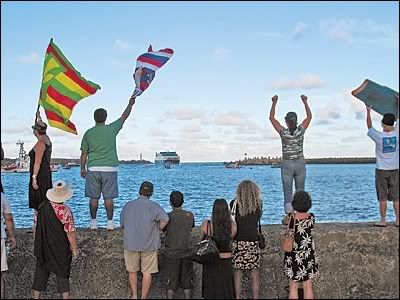
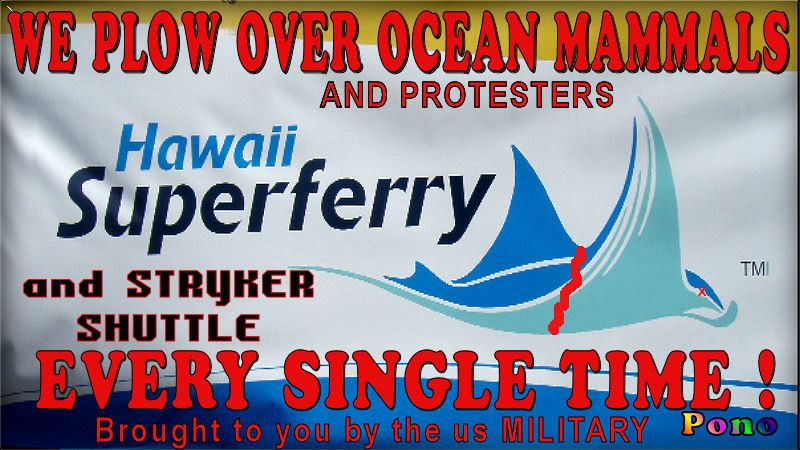 Invasion of the superferries: depleted uranium in paradise and other Hawai'ian revelationsby James HeddleDecember 2, 2008A Review of THE SUPERFERRY CHRONICLES: Hawaii's Uprising Against Militarism, Commercialism and the Desecration of the Earthby Koohan Paik & Jerry Mander.[Available from: http://www. koabooks. com/ ISBN13:978-0-9773338-9-9 ]The sleek, aluminum mega-catamaran streaksacross the sea swells at forty miles an hour. Powered by jet engines, it rides high, skimming the surface on twin hulls that slice sharply through the water...and also, incidentally, accidentally through any dolphins, whale pups, sea turtles or, for that matter, human protesters that happen to get in the way.Five stories high and a football field-and-a-half long, the superferry can carry 866 civilian or military personnel, 282 civilian cars and trucks...or an unknown quantity of Stryker Depleted Uranium-firing military tanks across the high seas and into shallow water on any island chain or continent. China, and other potential US rivals, please take note.It’s the prototype for a new generation of US Navy attack craft. The superferry is designed as part of the Pentagon's Littoral Combat Ship and Joint High Speed Vessel programs as their contribution to ‘Full Spectrum Dominance’ power projection policy in the Pacific... not to mention all around the watery globe in pursuit of ‘American [Business] Interests.’The superferry, which was apparently started as an quasi-idealistic business venture by small-time Silicon Valley software entrepreneur Timothy Dick, is now the pet project of John F.(for First Nuclear Strike) Lehman - a Nixon-Kissinger-Reagan-Bush-Pearl confidant, Project for a New American Century (PNAC) fellow traveler - and CEO, Admiral Thomas Fargo (former head of the U.S. Pacific Command). Both are major players in the American ‘defense community’ and its attendant, mucho-lucrative industries.Poor Timothy was squeezed out long ago as the profitability potential - not to mention the military advantages - to be gained from the project came clear.Light Bulb! Dollar Signs! This baby can become the catamaran that laid the golden egg - if the Navy contracts to mass produce it for world-around oceanic power projection.Yet, in Hawaii the superferry is being spun as a benign, almost selflessly humanitarian, local inter-island transportation effort on behalf of (you guessed it) The People.As such, it should be exempt from state and federal environmental impact laws. Right?It should exclude from any democratic choice the local populations most affected by the sudden influx of tourists-and-their-trash, tourist car exhaust fumes, and practice invasions by Depleted Uranium-firing tanks. Right?The US Government should underwrite the project with a $140,000 loan. Right?Anyway, that's what Hawaii's counterpart to Alaska's Sarah Palin, the ambitious Republican Governor Linda Lingle and longtime military maven Sen. Daniel Inouye , not to mention Norman Mineta, head of the U.S. Department of Transportation (USDOT) are using their considerable leverage to advocate.Trouble is, The People aren't buying it. And there's the rub.Turns out it’s The People's ardent, courageous, and (so far) effective opposition to the project that has slowed it down and prevented the planned deployment of the superferry from its Honolulu hub throughout the islands. The authors report that, “…there is no sure victory yet…. [ but ] At least for now, the Hawaii Superferry does not go to Kaua’i, and the …protests have achieved legendary status on the islands.” As the book goes to press in the Fall of 2008, “…the boat is still running to Maui, as the legal battles continue. The so-called Environmental Impact Statement mandated last year by a special session of the state legislature is in process, though it is merely a disclosure document (unlike a real EIS under federal or state law), one that will not require the company to actually mitigate any environmental concerns.” But the resistance continues to be fertile. Ironically, the plan to link the islands by superferries has, instead, united the islands in grassroots opposition.That's the outrageous, galvanizing, empowering, unfinished story told in the just-published SUPER FERRY CHRONICLES by Koohan Paik and Jerry Mander.Co-author Paik is a journalist, media educator and award-winning filmmaker based on the island of Kaua’i, the first target of the invasion.Mander is a former progressive ad man, author (Four Arguments for the Abolition of Television, In the Absence of the Sacred, among other books), and director of the International Forum on Globalization (IFG), a San Francisco-based ‘think tank’ dedicated since 1914 to exposing the negative impacts of economic globalization.SUPER FERRY CHRONICLES tells the global story behind the local headlines and scant national media coverage of this micro/macrocosmic struggle. It documents a new front in Hawaii's long-term, on-going, unstoppable indigenous sovereignty movement. This movement has continued since US sugar-growers, backed by US fire power, deposed the indigenous government and land-grabbed via military annexation, a chain of pristine islands that would later become a state and a launch pad for US power projection smack dab in the middle of the Pacific.As co-author Paik puts it, “ From an American geopolitical perspective, Hawai’i’s purpose has always been to function as mission control [her italics] for its military endeavors.” As this book makes clear, in this struggle, as in so many others around the planet, the local is the global and the global is the local.The SUPER FERRY CHRONICLES weaves together a moving mosaic of informed commentary and in depth reporting by the co-author/editors with the voices of local activists and investigative reporters – including celebrated indigenous rights activist Haunani-Kay Trask - to lay the complex backstory bare. Forget about the latest 007 pseudo-thriller Quantum of Solace. This actuality investigative expose’ rocks!As co-author Jerry Mander points out, the interlaced high geo-political v. local drama, the cast of heavies and heros, and the narrative ironies involved in this story make it ‘Hollywood Material’ for a block-buster feature film along the lines of Wall Street, Michael Clayton or Syriana. This is a real-life action-intrigue drama, he points out, even without (as yet) any murder or sex (that we know of so far).Like indigenous and local rights movements in Africa, South American and Asia; like California's so-far-successful citizen Stop-the-Spray movement to ban the rural and urban aerial and ground spraying of toxic pesticides; like the national grassroots Election Protection movement that helped prevent yet another stolen election in the U.S. this November, Hawai’i’s grassroots campaign against the 'Invasion of the SuperFerries' is one of a growing number of deep democracy eruptions that signal a new era of progressive planetarian politics.Never before, in so many places - local, national and international - on every continent, have so many grassroots people, able activists, cultural creatives, progressive business leaders and elected officials been at work on so many issues. This timely book is one of a proliferating number of reminders that, rest assured, the immune system of the planetary body politic has kicked in and is rising to the cosmic occasionKudos and appreciations to co-creators Paik and Mander for completing the massive task of bringing this complex local/global drama in eminently readable form to the wide audience it deserves.Given President-Elect Obama's deep personal connection to the Islands, one can't help but hope that this book will find its way into his hands and mind and heart and that he will use his good office to 'do the right thing' on this issue.---James Heddle is a mediamaker based in Northern California. He is co-director, with Mary Beth Brangan, of EON, the Ecological Options Network www. EON3. net . Kudos or komplaints to Jim@EON3.net
Invasion of the superferries: depleted uranium in paradise and other Hawai'ian revelationsby James HeddleDecember 2, 2008A Review of THE SUPERFERRY CHRONICLES: Hawaii's Uprising Against Militarism, Commercialism and the Desecration of the Earthby Koohan Paik & Jerry Mander.[Available from: http://www. koabooks. com/ ISBN13:978-0-9773338-9-9 ]The sleek, aluminum mega-catamaran streaksacross the sea swells at forty miles an hour. Powered by jet engines, it rides high, skimming the surface on twin hulls that slice sharply through the water...and also, incidentally, accidentally through any dolphins, whale pups, sea turtles or, for that matter, human protesters that happen to get in the way.Five stories high and a football field-and-a-half long, the superferry can carry 866 civilian or military personnel, 282 civilian cars and trucks...or an unknown quantity of Stryker Depleted Uranium-firing military tanks across the high seas and into shallow water on any island chain or continent. China, and other potential US rivals, please take note.It’s the prototype for a new generation of US Navy attack craft. The superferry is designed as part of the Pentagon's Littoral Combat Ship and Joint High Speed Vessel programs as their contribution to ‘Full Spectrum Dominance’ power projection policy in the Pacific... not to mention all around the watery globe in pursuit of ‘American [Business] Interests.’The superferry, which was apparently started as an quasi-idealistic business venture by small-time Silicon Valley software entrepreneur Timothy Dick, is now the pet project of John F.(for First Nuclear Strike) Lehman - a Nixon-Kissinger-Reagan-Bush-Pearl confidant, Project for a New American Century (PNAC) fellow traveler - and CEO, Admiral Thomas Fargo (former head of the U.S. Pacific Command). Both are major players in the American ‘defense community’ and its attendant, mucho-lucrative industries.Poor Timothy was squeezed out long ago as the profitability potential - not to mention the military advantages - to be gained from the project came clear.Light Bulb! Dollar Signs! This baby can become the catamaran that laid the golden egg - if the Navy contracts to mass produce it for world-around oceanic power projection.Yet, in Hawaii the superferry is being spun as a benign, almost selflessly humanitarian, local inter-island transportation effort on behalf of (you guessed it) The People.As such, it should be exempt from state and federal environmental impact laws. Right?It should exclude from any democratic choice the local populations most affected by the sudden influx of tourists-and-their-trash, tourist car exhaust fumes, and practice invasions by Depleted Uranium-firing tanks. Right?The US Government should underwrite the project with a $140,000 loan. Right?Anyway, that's what Hawaii's counterpart to Alaska's Sarah Palin, the ambitious Republican Governor Linda Lingle and longtime military maven Sen. Daniel Inouye , not to mention Norman Mineta, head of the U.S. Department of Transportation (USDOT) are using their considerable leverage to advocate.Trouble is, The People aren't buying it. And there's the rub.Turns out it’s The People's ardent, courageous, and (so far) effective opposition to the project that has slowed it down and prevented the planned deployment of the superferry from its Honolulu hub throughout the islands. The authors report that, “…there is no sure victory yet…. [ but ] At least for now, the Hawaii Superferry does not go to Kaua’i, and the …protests have achieved legendary status on the islands.” As the book goes to press in the Fall of 2008, “…the boat is still running to Maui, as the legal battles continue. The so-called Environmental Impact Statement mandated last year by a special session of the state legislature is in process, though it is merely a disclosure document (unlike a real EIS under federal or state law), one that will not require the company to actually mitigate any environmental concerns.” But the resistance continues to be fertile. Ironically, the plan to link the islands by superferries has, instead, united the islands in grassroots opposition.That's the outrageous, galvanizing, empowering, unfinished story told in the just-published SUPER FERRY CHRONICLES by Koohan Paik and Jerry Mander.Co-author Paik is a journalist, media educator and award-winning filmmaker based on the island of Kaua’i, the first target of the invasion.Mander is a former progressive ad man, author (Four Arguments for the Abolition of Television, In the Absence of the Sacred, among other books), and director of the International Forum on Globalization (IFG), a San Francisco-based ‘think tank’ dedicated since 1914 to exposing the negative impacts of economic globalization.SUPER FERRY CHRONICLES tells the global story behind the local headlines and scant national media coverage of this micro/macrocosmic struggle. It documents a new front in Hawaii's long-term, on-going, unstoppable indigenous sovereignty movement. This movement has continued since US sugar-growers, backed by US fire power, deposed the indigenous government and land-grabbed via military annexation, a chain of pristine islands that would later become a state and a launch pad for US power projection smack dab in the middle of the Pacific.As co-author Paik puts it, “ From an American geopolitical perspective, Hawai’i’s purpose has always been to function as mission control [her italics] for its military endeavors.” As this book makes clear, in this struggle, as in so many others around the planet, the local is the global and the global is the local.The SUPER FERRY CHRONICLES weaves together a moving mosaic of informed commentary and in depth reporting by the co-author/editors with the voices of local activists and investigative reporters – including celebrated indigenous rights activist Haunani-Kay Trask - to lay the complex backstory bare. Forget about the latest 007 pseudo-thriller Quantum of Solace. This actuality investigative expose’ rocks!As co-author Jerry Mander points out, the interlaced high geo-political v. local drama, the cast of heavies and heros, and the narrative ironies involved in this story make it ‘Hollywood Material’ for a block-buster feature film along the lines of Wall Street, Michael Clayton or Syriana. This is a real-life action-intrigue drama, he points out, even without (as yet) any murder or sex (that we know of so far).Like indigenous and local rights movements in Africa, South American and Asia; like California's so-far-successful citizen Stop-the-Spray movement to ban the rural and urban aerial and ground spraying of toxic pesticides; like the national grassroots Election Protection movement that helped prevent yet another stolen election in the U.S. this November, Hawai’i’s grassroots campaign against the 'Invasion of the SuperFerries' is one of a growing number of deep democracy eruptions that signal a new era of progressive planetarian politics.Never before, in so many places - local, national and international - on every continent, have so many grassroots people, able activists, cultural creatives, progressive business leaders and elected officials been at work on so many issues. This timely book is one of a proliferating number of reminders that, rest assured, the immune system of the planetary body politic has kicked in and is rising to the cosmic occasionKudos and appreciations to co-creators Paik and Mander for completing the massive task of bringing this complex local/global drama in eminently readable form to the wide audience it deserves.Given President-Elect Obama's deep personal connection to the Islands, one can't help but hope that this book will find its way into his hands and mind and heart and that he will use his good office to 'do the right thing' on this issue.---James Heddle is a mediamaker based in Northern California. He is co-director, with Mary Beth Brangan, of EON, the Ecological Options Network www. EON3. net . Kudos or komplaints to Jim@EON3.netNini'ane
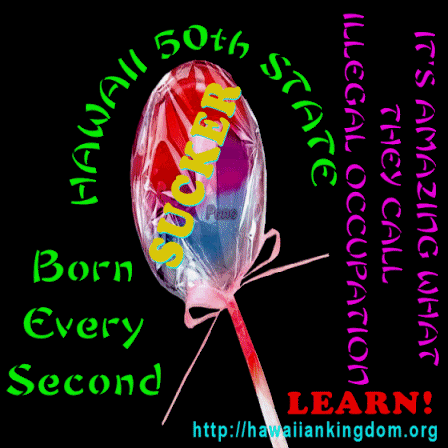

 Yup thats part of their livelihood and culture !!! Having the children of the countries they occupy to conform in one way or another and then comply in order to continue to live the blatant fictitious lie so that they have sustenance of life here.Unfortunately it will continue to go on as long as people continue to as Soli says be silenced.http://www.hawaiireporter.com/story.aspx?d7b4b35d-9439-4d66-8534-c7a4afd2f140MAHALOHOW LONG WILL THIS BULLSHET GO ON ! USE THE CHILDREN TO CONTINUE THIS FRICKEN LIES ,KUKAE!Local Students' Designs Are Finalists in Hawaii Statehood T-Shirt Design ContestContest Attracts Entries from 1,063 studentsBy Kathleen Hanover, 12/12/2008 8:49:24 AMHAWAII - Over 1,000 Hawaii schoolchildren from 45 different schools entered the t-shirt design contest sponsored by HawaiiStatehoodApparel.com, a souvenir apparel wholesaler. Several local students* were chosen as finalists.The following Oahu students' designs can be seen online at http://www.hawaiistatehoodapparel.com/contest :From Kalakaua Middle School:Brianna, 6th Grade; Alanda, 7th Grade; Robert, 7th Grade; Kenneth, 8th GradeFrom Kalani High School:Iolani, 9th GradeFrom Our Savior Lutheran School:Mallory, 3rd GradeFrom Sacred Hearts Academy:Megan, 4th Grade; Isabel, 5th Grade; Connie, 6th Grade; Maile, 7th GradeFrom Shafter Elementary:Anthony, KindergartenFrom St Louis School:Kainoa, 8th GradeThe winners in each grade level will be announced within the next two weeks.Students in grades K-12 throughout Hawaii were invited to create t-shirt designs that commemorate Hawaii's 50th anniversary of statehood in 2009. The winner in each grade level will have their creations featured on screen-printed t-shirts available for wholesale purchase through the site. Each winning t-shirt designer will receive a $100 U.S. Savings Bond, plus 50 t-shirts bearing their original artwork. And each winner's school will earn 5% of the profits from sales of the winning design.Design motifs included palm trees, sea turtles, Hula dancers, hibiscus flowers, surfboards, beaches, Hawaii's state flag, tropical sunsets, outrigger canoes, ukuleles, Kamehameha the Great, and many other Hawaiian icons.Don Alfano, the founder of HawaiiStatehoodApparel.com, said he was overwhelmed by the response. "The judges and I had a very difficult time choosing the three best designs for each grade level." Alfano continued, "We were also impressed with the quality of the designs. We're very excited to offer t-shirts that commemorate Hawaii's past, designed by the kids who represent Hawaii's future."HawaiiStatehoodApparel.com features Hawaii Statehood apparel and accessories available for wholesale purchase by retail outlets such as souvenir shops, apparel retailers, surf shops, golf resorts, plus schools, clubs and organizations. The site offers 50th anniversary t-shirts, Hawaiian shirts, golf shirts, and accessories.
Yup thats part of their livelihood and culture !!! Having the children of the countries they occupy to conform in one way or another and then comply in order to continue to live the blatant fictitious lie so that they have sustenance of life here.Unfortunately it will continue to go on as long as people continue to as Soli says be silenced.http://www.hawaiireporter.com/story.aspx?d7b4b35d-9439-4d66-8534-c7a4afd2f140MAHALOHOW LONG WILL THIS BULLSHET GO ON ! USE THE CHILDREN TO CONTINUE THIS FRICKEN LIES ,KUKAE!Local Students' Designs Are Finalists in Hawaii Statehood T-Shirt Design ContestContest Attracts Entries from 1,063 studentsBy Kathleen Hanover, 12/12/2008 8:49:24 AMHAWAII - Over 1,000 Hawaii schoolchildren from 45 different schools entered the t-shirt design contest sponsored by HawaiiStatehoodApparel.com, a souvenir apparel wholesaler. Several local students* were chosen as finalists.The following Oahu students' designs can be seen online at http://www.hawaiistatehoodapparel.com/contest :From Kalakaua Middle School:Brianna, 6th Grade; Alanda, 7th Grade; Robert, 7th Grade; Kenneth, 8th GradeFrom Kalani High School:Iolani, 9th GradeFrom Our Savior Lutheran School:Mallory, 3rd GradeFrom Sacred Hearts Academy:Megan, 4th Grade; Isabel, 5th Grade; Connie, 6th Grade; Maile, 7th GradeFrom Shafter Elementary:Anthony, KindergartenFrom St Louis School:Kainoa, 8th GradeThe winners in each grade level will be announced within the next two weeks.Students in grades K-12 throughout Hawaii were invited to create t-shirt designs that commemorate Hawaii's 50th anniversary of statehood in 2009. The winner in each grade level will have their creations featured on screen-printed t-shirts available for wholesale purchase through the site. Each winning t-shirt designer will receive a $100 U.S. Savings Bond, plus 50 t-shirts bearing their original artwork. And each winner's school will earn 5% of the profits from sales of the winning design.Design motifs included palm trees, sea turtles, Hula dancers, hibiscus flowers, surfboards, beaches, Hawaii's state flag, tropical sunsets, outrigger canoes, ukuleles, Kamehameha the Great, and many other Hawaiian icons.Don Alfano, the founder of HawaiiStatehoodApparel.com, said he was overwhelmed by the response. "The judges and I had a very difficult time choosing the three best designs for each grade level." Alfano continued, "We were also impressed with the quality of the designs. We're very excited to offer t-shirts that commemorate Hawaii's past, designed by the kids who represent Hawaii's future."HawaiiStatehoodApparel.com features Hawaii Statehood apparel and accessories available for wholesale purchase by retail outlets such as souvenir shops, apparel retailers, surf shops, golf resorts, plus schools, clubs and organizations. The site offers 50th anniversary t-shirts, Hawaiian shirts, golf shirts, and accessories.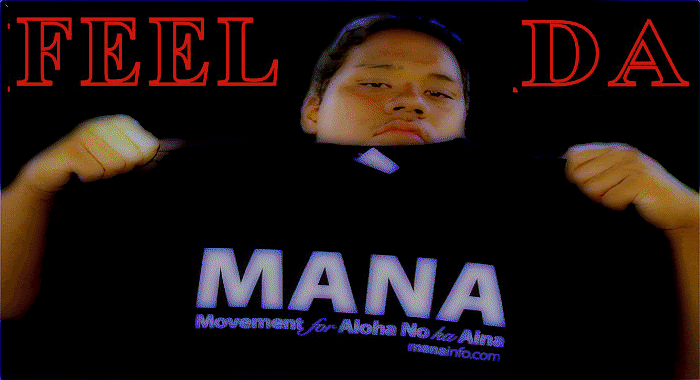 LEARN !http://hawaiiankingdom.org
LEARN !http://hawaiiankingdom.org
The Massie case: Injustice and courage
By David Stannard
Seventy years ago last month, in the pre-dawn hours of a Sunday morning, two Honolulu police officers awakened a young man named Horace Ida at his home in Kalihi-Palama. Ida dressed hurriedly and went with the detectives, thinking he knew what they were after
collision with another auto at the corner of King and Liliha streets. An argument broke out and one of the men riding with Ida got in a brief scuffle with a woman in the other car. Ida assumed the woman remembered his license plate number and decided to file charges.
But soon after arriving at police headquarters Henry Ida found himself under arrest for a far more serious crime. The 20- year-old wife of a Pearl Harbor Navy officer identified him as one of five local men who allegedly had kidnapped, beaten, and repeatedly raped her earlier that evening after she had left a Waikiki nightclub alone.
The woman's name was Thalia Massie, the daughter of a wealthy and politically powerful Washington, D.C., couple. And for the better part of the next year Honolulu was swept up in an unprecedented frenzy of accusations, threats, and violence.
"The Massie case" remains the most notorious criminal incident in the modern history of Hawai'i. Associated Press editors in 1932 voted it, along with the Lindbergh baby kidnapping, the biggest criminal case in the country. Books and articles have been written about it, and at least one Hollywood film was based — very loosely — on it. But by now many people have forgotten what actually happened, and many more have never heard of the case.
The story deserves retelling because it remains powerfully relevant today. Not only because of the tragedy and racial injustice associated with the case but also because of its less-heralded lessons in straightforward moral courage.
Controlling the story
All the men accused of raping Thalia Massie were from impoverished or working class backgrounds. Two were Hawaiian, two were Japanese, and one was Chinese-Hawaiian. From the start, based on little or no evidence, local newspapers assumed the men were guilty and referred to them in print as "thugs," "degenerates," and "fiends." Their alleged victim was described as "a white woman of refinement and culture."
Although the Honolulu press would be filled for months with racially inflammatory articles and editorials on the case, few in the business, political, or military communities wanted the story to spread beyond the Islands. During the preceding decade tourism had begun to take off, Hawai'i's semi-autonomous political status remained precarious, and the Navy commandant at Pearl Harbor was not eager for Washington to question his ability to maintain order. A blanket was thrown over news of the events, and at first the story was confined almost entirely to local newspaper accounts.
At the same time, authorities pressed for an aggressive prosecution to placate an enraged Navy and local haole community. Few expected anything but a quick conviction and lengthy prison sentences for the five men
Vicious, racist violence
jurors declared themselves deadlocked. A mistrial was declared. Before a decision could be made about retrying the five men, however, Thalia Massie's supporters and family took matters into their own hands.
First, Horace Ida was seized on a Honolulu street by a carload of sailors and was beaten, clubbed, and whipped with leather belts. Then, with the aid of two Navy enlisted men, Thalia's husband and mother kidnapped and murdered one of the other defendants, Joseph Kahahawai. Police captured the killers with Kahahawai's naked corpse, wrapped in a bloody sheet, lying on the back seat of their car as they were driving toward Koko Head to dispose of it.
At this point the story could be contained no longer. As the story erupted in the United States, the president called a special Cabinet meeting at the White House. Congress held emergency weekend hearings. The Justice Department and the FBI sent a team of investigators to Hawai'i. Every major American newspaper ran front-page stories on the case.
Sympathy for white woman
Almost without exception, the expressed sympathy of America's politicians and journalists was not for the murdered young man, but for his killers. From coast to coast newspapers, magazines, and radio commentators described Hawai'i as — in the words of a syndicated Hearst editorial — a place where "the roads go through jungles, and in those remote places bands of degenerate natives lie in wait for white women driving by."
Not to be outdone, Time magazine blamed the killing of Joseph Kahahawai on the victim and his friends, describing them as "five brown-skinned young bucks" who demonstrated the well-known "lust of mixed breeds for white women" when they raped Thalia Massie in the first place. The fact that the men had not been convicted of the alleged crime by a local jury only proved to the American press that Hawai'i itself was a "cesspool" of anti-white racial hatred that did not deserve territorial status.
Accordingly, the New York Post called for a battleship to sail into Honolulu harbor and rescue the killers from the civil authorities who had them under arrest. And everywhere the cry went up for the United States to impose martial law in the Islands.
Darrow defends killers
Into this furor, then, stepped Clarence Darrow, the most famous criminal lawyer in American history. Much of Darrow's celebrity was based on his spectacular courtroom defenses of the oppressed and downtrodden.
But now, at age 74, he was broke, financially ruined by the Depression. So, for the equivalent of about $400,000 today, he agreed to defend four white people charged with killing a young Hawaiian man — a murder that even Darrow later admitted they were guilty of committing.
To a large extent Darrow's strategy was the same one used by defenders of lynching in the South. Asserting flatly that Kahahawai had indeed participated in a gang rape of Thalia Massie — something that Honolulu prosecutors had been unable to prove — Darrow took the position that the murder was a justified "honor killing." As such, he contended, customary "unwritten law" demanded that the accused should go free.
Facing Darrow across the courtroom was Honolulu's newly appointed prosecutor, John Kelley. From the first day of jury selection until their final summations Darrow and Kelley went to war with one another.
Years later the New York Times, which ran nearly 200 stories on the case while it was in progress, would recall it as one of Darrow's three most compelling trials ever. The others were the Scopes "Monkey Trial" over the teaching of evolution in Tennessee and the Leopold and Loeb murder trial in Chicago. But neither of the other two, the Times said, contained a moment of high drama to compare with Thalia Massie — under cross-examination by prosecutor Kelley — tearing a piece of evidence to shreds on the witness stand and rushing across the courtroom in tears to the waiting arms of her husband and the applause of a standing-room-only crowd of spectators.
Getting away with a lie
a special radio hookup was installed so that Darrow's closing argument could be carried live on the American continent.
Few juries have ever been under as much pressure as this one. On the one hand, there was no doubt that the four accused defendants had killed Joseph Kahahawai. On the other hand, there was equally little doubt that a conviction would bring, at the very least, what was called a "commission" form of government to Hawai'i, an arrangement only one step short of martial law. Congress and the American press had openly warned of such a consequence, and even prosecutor Kelley — while appealing to the jury for a verdict of guilty — admitted that a fair and honorable decision by them could mean the end of civilian rule in the Islands.
In addition, many of the jurors were employed by companies controlled by the corporate oligarchy that then dominated business in Hawai'i or they worked for firms with close connections to the Navy. Thus, their livelihoods and the economic well being of their families were at stake, in addition to the threatened political status of the place that was their home.
Surprising many who expected another hung jury, the panel reached a verdict. The defendants were found guilty of manslaughter. It wasn't murder, but it was a conviction carrying a mandatory sentence of 10 years imprisonment.
Predictably, the national uproar grew louder. The thought that three white U.S. Navy men and a middle-aged Washington socialite might spend time in the Territorial prison — even if they had kidnapped and murdered a young Hawaiian man — seemed unthinkable.
And, as things turned out, it was. Despite the verdict, the killers would never spend a day in prison. After a flurry of diplomatic maneuvering between Washington and Honolulu, Territorial Governor Lawrence Judd commuted the sentences of the convicted killers to one hour, to be served in his office. In return, Hawai'i was spared martial law until the outbreak of World War II.
Within days of the commutation the Massies, Thalia's mother, the convicted Navy men, and Clarence Darrow boarded a ship and left Hawai'i forever. Months later, an independent investigation by Mainland detectives, funded by the Territory, demonstrated beyond doubt that the accused men could not possibly have committed the alleged rape. Indeed, compelling evidence suggested that the supposed crime had never even occurred.
Cult of the killers
The first historical assessments of the Massie case were not written until the mid-1960s
and since have focused with tabloid-like fascination on those characters in the drama who behaved most contemptibly.
They include Thalia Massie, who falsely charged the five men in the first place; Thalia's husband and mother, and the Navy enlisted men who helped the other two murder an innocent man; Navy Adm. Yates Stirling, who fabricated lies about conditions in Hawai'i in an effort to advance his own career; and Clarence Darrow, who borrowed a tactic from the Ku Klux Klan to defend his clients.
Heroism left out of story
In contrast, little attention has been paid to those who behaved well under extraordinarily difficult circumstances. And yet it is with them — a true racial and ethnic cross-section of Hawai'i then and now — that the valuable lessons of the Massie case reside.
First there are the accused men themselves. Horace Ida, Joseph Kahahawai, Henry Chang, David Takai, and Benjamin Ahakuelo. One of them was nearly beaten to death. Another was kidnapped, then shot and killed with a single bullet to his heart. All of them endured months of vicious defamation in the press and the threat of lengthy imprisonment for a crime they did not commit. And police and prosecutors tried all the usual tactics — including individual offers of immunity if one would inform on the others — and some that were not so usual, such as pitting the men against one another racially. Despite the threats and enticements, none of them ever budged from their insistence that they had done nothing wrong.
Then there were the lawyers who stepped forward in the first trial to defend the accused men without compensation. William Heen, of Chinese-Hawaiian ancestry, perhaps the best attorney in the Islands and the first non-haole Circuit Court judge in the Territory. A young local Japanese lawyer, Robert Murakami, recently graduated from the University of Chicago Law School. And a prominent haole originally from Mississippi, William Pittman.
Not only did they put their careers on the line, defending five almost penniless young men amid racial and political near-hysteria, but they did so by publicly exposing that turmoil for what it was. And none did so more effectively than Pittman, in a Southern drawl, summing up his defense by accusing the prosecution of bending to the will of "a conspiracy of white people — the small group of hypocritical haoles more anxious to satisfy the Navy than to seek justice."
After the murder of Joseph Kahahawai the grand jury at first refused to indict the killers, despite the fact that they had been caught with the dead man's body in the back seat of their car. Of the grand jury's 21 members 19 were white. And, as one of them openly said, they were fearful of what would happen to their "standing in the community" if they voted to indict four well-connected white people for the murder of a poor Hawaiian. But the judge, Albert Cristy, who also was white, risked disqualification from the case and possibly his entire judicial future by repeatedly demanding an indictment from the grand jurors — and finally getting it.
Then there was Jack Kelley. Originally from Montana and a former law partner of William Heen, Kelley was trying his first case as a prosecutor when he went up against Clarence Darrow. Not intimidated by the immense political pressure he was under or by the legendary reputation of his opposing counsel, he matched Darrow point for point. Describing Darrow's defense as advocacy of the "serpent of lynch law," he warned the jury that nothing could be worse than allowing that to become the law of the land.
The jury was made up of three haole-Hawaiians, two local Chinese, one Portuguese, and six whites. After two days of deliberation — and fully aware of the ominous larger consequences — they brought in their unanimous verdict of guilty.
Darrow was outraged. Of the non-white jurors, he complained that during the trial "it was not easy to guess what they were thinking about, if anything at all." Adding that "obviously they do not think as we do," he concluded that "a jury of white men would have acquitted." With this last comment Darrow conveniently forgot that a single negative vote from among the jury's half-dozen haole members would have blocked the convictions.
Together with the first jury that had deadlocked in the rape trial, 24 jurors had heard both cases in an intensely politicized and menacing environment. Among them were seven whites, nine haole-Hawaiians, four Chinese, two Portuguese, and two Japanese. None had anything personal to gain — and a great deal to lose — by facing down the local and national white power structure and voting their consciences. They did it anyway.
There were others. Princess Abigail Kawananakoa, Hawai'i's conservative Republican National committeewoman and a wealthy heiress to the Hawaiian monarchy, received a telephone call one night at her elegant home. It was from someone she had never met, a poor Hawaiian woman whose son had been arrested for a crime she said he didn't commit. After speaking to Joseph Kahahawai's mother for a while, the Princess hung up and called William Heen, urging him to take the case. She followed the subsequent events closely, speaking out publicly against what she called the "travesty" of a two-tiered justice system in the Islands, "one for the favored few and another for the people in general."
At a very different place on the Islands' social scale, George Wright was the haole editor of the English-language section of the Japanese newspaper Hawaii Hochi. Wright had been a civilian machinist at Pearl Harbor before being fired for union activities. Along with his boss, Hochi publisher and editor Frederick Makino, of haole and Japanese parentage, Wright maintained a lonely editorial drumbeat of criticism throughout the entire Massie affair — pointing out crippling flaws in the charges against the five men from the very beginning and never wavering from a demand for justice in the face of an avalanche of racial prejudice.
Need to remember
Just as it is essential that we continue to remember those who stood up to the likes of Joseph McCarthy in the 1950s, so it is important that we honor those who publicly opposed the forces of racism and oppression during the Massie case.
It took character and courage to speak out against the racial and political injustices that permeated life in Hawai'i at that time, at a time when a former Advertiser assistant editor recalled how American naval officers commonly referred to Hawaiians as "niggers."
The example should cause all of us to consider what we would have done under those circumstances — and to reflect on what we are doing now, as more subtle forms of oppression tear at Hawai'i's social fabric. What will people think, 70 years from now, as they look back on how we treat the poorest and the weakest and most damaged among us? How we behave now will be our most enduring legacy.
http://the.honoluluadvertiser.com/article/2001/Oct/14/op/op03a.html
David Stannard is a professor of American Studies at the University of Hawai'i. He is writing a book on the Massie case that focuses on the involvement of local people in that struggle for justice. He would like to hear from anyone with personal memories or family stories or photographs about the events of that time. You can call him at 235-4924, e-mail him at stannard@hawaii.rr.com, or write to him at the Department of American Studies, University of Hawai'i, Hono-lulu, HI 96822.
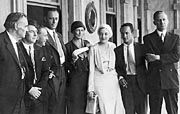 The four defendants and their supporters were at 'Iolani Palace shortly after being found guilty of manslaughter and sentenced to serve a one-hour "prison term" in 1932. From left: Clarence Darrow, chief defense counsel; defendants E.J. Lord and A.O. Jones; Maj. Gordon Ross, high sheriff; Grace Fortescue, mother of Thalia Massie and niece of inventor Alexander Graham Bell; Thalia and Lt. Thomas Massie; and George Leisure, defense counsel.
The four defendants and their supporters were at 'Iolani Palace shortly after being found guilty of manslaughter and sentenced to serve a one-hour "prison term" in 1932. From left: Clarence Darrow, chief defense counsel; defendants E.J. Lord and A.O. Jones; Maj. Gordon Ross, high sheriff; Grace Fortescue, mother of Thalia Massie and niece of inventor Alexander Graham Bell; Thalia and Lt. Thomas Massie; and George Leisure, defense counsel. Benny Ahakuelo was accused of taking part in a gang rape.
Benny Ahakuelo was accused of taking part in a gang rape. Henry Chang was defamed as part of a gang of young bucks.
Henry Chang was defamed as part of a gang of young bucks. Horace Ida was beaten over a crime he didn't commit.
Horace Ida was beaten over a crime he didn't commit. Joe Kahahawai was killed after a rape trial ended in hung jury.
Joe Kahahawai was killed after a rape trial ended in hung jury. David Takai, like others accused, stuck to his word.
David Takai, like others accused, stuck to his word.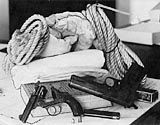 Evidence presented by authorities showed that Joseph Kahahawai had been kidnapped, shot to death, and wrapped in a bloody sheet.
Evidence presented by authorities showed that Joseph Kahahawai had been kidnapped, shot to death, and wrapped in a bloody sheet.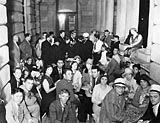 Hundreds of Hawai'i residents and others tried to gain access to the courtroom during the Massie trial but were turned away.
Hundreds of Hawai'i residents and others tried to gain access to the courtroom during the Massie trial but were turned away.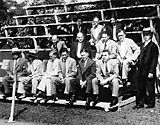 Jury members in Joseph Kahahawai's murder trial broke from deliberations at one point to attend a baseball game. The jury refused to accept the racism embedded in the arguments presented by the defense.
Jury members in Joseph Kahahawai's murder trial broke from deliberations at one point to attend a baseball game. The jury refused to accept the racism embedded in the arguments presented by the defense.
Lingle's Stance On Ceded Lands Justified
Gov. Linda Lingle is taking a beating from Native Hawaiians in the legal dispute over ceded lands, but she has little choice other than to defend the state's right to manage its resources for the benefit of all citizens.
The act specified betterment of Native Hawaiians as one of five purposes the lands should be put to, along with public education, farm and home ownership and general public improvements.
The Hawai'i Supreme Court ruled in January, however, that the state can't sell or transfer any of the lands until Hawaiian native claims are reconciled — a process that could take decades while restricting the state's ability to address other priorities in the act.
Hawaiians excoriated the Lingle administration for requesting a review of the state ruling by the U.S. Supreme Court, which took the case and has scheduled oral arguments on Feb. 25.
In a Nov. 24 rally at the Capitol, some Hawaiian protesters shouted for Lingle's impeachment and an attorney representing the Office of Hawaiian Affairs in the lawsuit has accused her of taking an "immoral position."
The harsh tone of the criticism is unfair.
Lingle, who inherited the lawsuit from the Cayetano administration, recognizes that Hawaiians have "strong moral claims" to compensation for lands taken after the overthrow of the Hawaiian monarchy, but disputes the state Supreme Court's view that the state's title to ceded lands granted by the Admissions Act was effectively nullified by a 1993 congressional resolution apologizing for the overthrow.
Sen. Daniel Inouye told colleagues at the time that the measure was "a simple resolution of apology" and had "nothing to do" with Hawaiian land claims.
Lingle believes land claims must be sorted out via the Akaka bill in Congress and has made several trips to Washington to lobby for the measure despite opposition from conservatives in her Republican Party.
The Hawai'i Supreme Court ruling was extraordinary in the way it interpreted federal laws to strip the state of sovereign rights.
It's little wonder that 29 other states worried about their own sovereign rights joined Hawai'i in seeking a U.S. Supreme Court review, and that the court considered it of sufficient national interest to hear the case.
Hawaiians are worried the court might erode their rights beyond the ceded lands issue, and it's a shame the dispute has gotten this far.
Reasonable people should have been able to reach a settlement that allowed the state to sell lands when necessary to meet the purposes of the Admissions Act, but with the understanding that it would do so with restraint until Hawaiian claims were resolved.
It's not as though the state planned a fire sale of ceded lands; the 1994 OHA lawsuit now before the Supreme Court involved a sale of 1,500 acres on Maui and the Big Island for affordable housing — one of the mandates of the act — with OHA getting one-fifth of the proceeds.
The case poses huge practical implications for the state, and Lingle isn't in a position to stand down now; even if the Akaka bill passes next year, it could take decades to reconcile Hawaiian land and sovereignty claims.
Hawaiians have no recognized leadership to negotiate with the federal government and objected to setting a 20-year deadline for settling the issues in the Akaka bill. Many Hawaiians oppose the Akaka bill altogether.
No state can operate effectively with its ability to manage its resources in indefinite limbo.
David Shapiro, a veteran Hawai'i journalist, can be reached by e-mail at dave@volcanicash.net. His columns are archived at www.volcanicash.net. Read his daily blog, Volcanic Ash, at volcanicash.honadvblogs.com.
Reach David Shapiro at dave@volcanicash.net.
ALOHA Kakou, Hawaii, Governor Lingle should be Impeached. As governor of the State of Hawaii, Lingle is the Executive Trustee of the Public Land Trust. Lingle has Betrayed the trust of many Hawaiians who supported and voted for her during the past six years. After six years of being governor, Lingle is supporting the Overthrow of the Inherent Sovereign Right of the Indigenous Hawaiian people to their national lands of the Hawaiian Kingdom.
 KU I KA PONO, December 26, 2008, o Pomaikaiokalani
KU I KA PONO, December 26, 2008, o Pomaikaiokalani
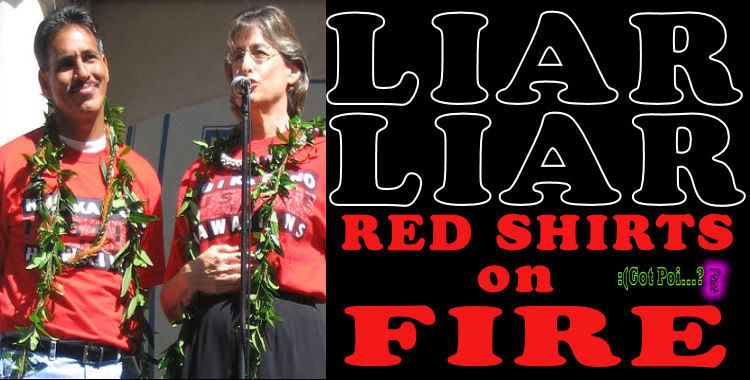
 SUPERFERRY SERVICE TO END SOON?Hawai'i Supreme Court To Decide New CaseThe Hawai`i Supreme Court, whose ruling last year led to a three-month shutdown of the Superferry, will decide whether the interisland service can continue in a new case to be heard next week.The court will decide whether Gov. Linda Lingle and the Legislature violated the state Constitution last year with a new law that allowed Superferry to resume operation while an environmental review of the project is completed.A ruling could have an immediate impact on whether Superferry can operate between O`ahu and Maui.
SUPERFERRY SERVICE TO END SOON?Hawai'i Supreme Court To Decide New CaseThe Hawai`i Supreme Court, whose ruling last year led to a three-month shutdown of the Superferry, will decide whether the interisland service can continue in a new case to be heard next week.The court will decide whether Gov. Linda Lingle and the Legislature violated the state Constitution last year with a new law that allowed Superferry to resume operation while an environmental review of the project is completed.A ruling could have an immediate impact on whether Superferry can operate between O`ahu and Maui.
